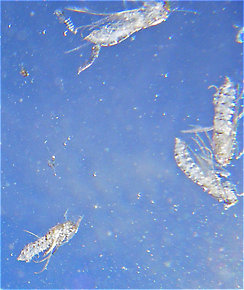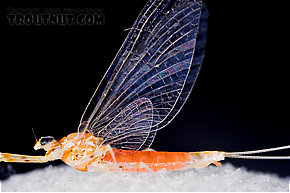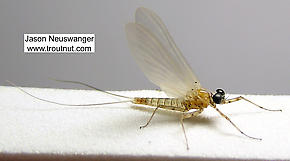Blog & Latest Updates
Fly Fishing Articles
Insects by Common Name


Mayfly Species Epeorus vitreus (Sulphur)
Taxonomic Navigation -?-
Kingdom
Animalia (Animals)
» Phylum
Arthropoda (Arthropods)
» Class
Insecta (Insects)
» Order
Ephemeroptera (Mayflies)
» Genus
Epeorus (Little Maryatts)
» Species vitreus (Sulphur)
Common Names
Where & When
This Midwestern hatch of Epeorus vitreus is a week or two behind the Eastern emergence.
I believe I encountered a fishable hatch of this species in the Catskills in early September, but I could not positively identify the flies.
Hatching Behavior
Epeorus vitreus emerges underwater. The duns reportedly leave their nymphal shucks (

Here's an underwater view of the pupal shucks of several already-emerged Brachycentrus numerosus caddisflies.
Spinner Behavior
Time Of Day: Early evening; later on hot days
Habitat: Riffles
The females oviposit by flying low over the water and repeatedly dipping their abdomens in and out. When they're done, they fall spent (Spent: The wing position of many aquatic insects when they fall on the water after mating. The wings of both sides lay flat on the water. The word may be used to describe insects with their wings in that position, as well as the position itself.) with the males.Habitat: Riffles
Nymph Biology
Current Speed: Medium to fast
Substrate: Boulders and gravel
These mayflies survive under a wider range of conditions than Epeorus pleuralis, but they do require a rock or gravel bottom. They do best in fast water.Substrate: Boulders and gravel
Epeorus vitreus Fly Fishing Tips
At a distance, this species is easily mistaken for other Sulphur species like Ephemerella invaria by the untrained eye who does not look beyond size and color. This is one more reason to quickly collect a dun if you're having trouble matching a Sulphur hatch.
Pictures of 15 Mayfly Specimens in the Species Epeorus vitreus:
Female Epeorus vitreus (Sulphur) Mayfly Spinner View 9 Pictures
View 9 Pictures
 View 9 Pictures
View 9 PicturesCollected September 19, 2006 from Mystery Creek #43 in New York
Added to Troutnut.com by Troutnut on October 4, 2006
Added to Troutnut.com by Troutnut on October 4, 2006
Female Epeorus vitreus (Sulphur) Mayfly Spinner View 7 Pictures
View 7 Pictures
 View 7 Pictures
View 7 PicturesCollected June 2, 2005 from the Namekagon River in Wisconsin
Added to Troutnut.com by Troutnut on May 24, 2006
Added to Troutnut.com by Troutnut on May 24, 2006
Male Epeorus vitreus (Sulphur) Mayfly Dun View 4 PicturesThis is my favorite mayfly from 2004, and it appears on my popular Be the Trout: Eat Mayflies products. Check them out!
View 4 PicturesThis is my favorite mayfly from 2004, and it appears on my popular Be the Trout: Eat Mayflies products. Check them out!
Its identification is really up in the air. It might be a late-season vitreus dun but it may very well be one of the more obscure species in that genus.
 View 4 PicturesThis is my favorite mayfly from 2004, and it appears on my popular Be the Trout: Eat Mayflies products. Check them out!
View 4 PicturesThis is my favorite mayfly from 2004, and it appears on my popular Be the Trout: Eat Mayflies products. Check them out!Its identification is really up in the air. It might be a late-season vitreus dun but it may very well be one of the more obscure species in that genus.
Collected September 2, 2004 from the Beaverkill River in New York
Added to Troutnut.com by Troutnut on January 25, 2006
Added to Troutnut.com by Troutnut on January 25, 2006
Your Thoughts On Epeorus vitreus:
Top 10 Fly Hatches
Top Gift Shop Designs
Eat mayflies.
Top Insect Specimens
Miscellaneous Sites
Troutnut.com is copyright © 2004-2024 Jason
Neuswanger (email Jason). See my FAQ for information about use of my images.
 privacy policy
privacy policy
